Lathe Chucks for Mini LathesWe have lots of options for lathe chucks for your 7x10, 7x12, 7x14, or 7x16 mini lathe.  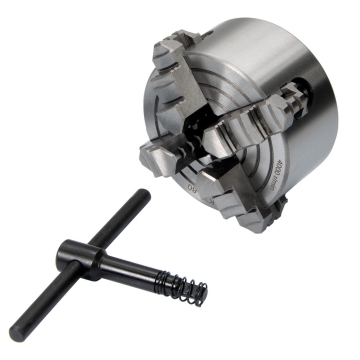
Before we start our discussion of lathe chucks, there’s one specification that you need to know; the diameter of the flange on your lathe’s spindle. It’s easy to figure out. If the lathe chuck that came on your lathe is about 3” in diameter, your spindle has an 80 mm flange. If the lathe chuck that came on your lathe is about 4” in diameter, your spindle has a 100 mm flange. The overwhelming majority of mini lathes have been shipped with a 3” lathe chuck.
Types of Lathe ChucksThe most common types of lathe chucks are 3-jaw self-centering and 4-jaw independent. These two are so common that they are usually just called 3-jaw and 4-jaw. The “self-centering” and “independent” are understood.
Other lathe chucks include 4-jaw self-centering and 6-jaw self-centering. These are relatively specialized and much less common than the normal 3-jaw and 4-jaw chucks. Sizes of Lathe ChucksMini lathes can use 3", 4" and 5" lathe chucks. Most mini lathes are shipped with a 3" 3-jaw chuck, but some, including the LittleMachineShop.com 7x16 HiTorque Mini Lathe ship with a 4" 4-jaw chuck. One restriction of a 3" 3-jaw chuck is that the center hole in the chuck is smaller than the hole through the spindle. You can run material up to 5/8" in diameter through a 3" 3-jaw chuck, which the mini lathe spindle will accommodate 3/4" diameter material. There are a couple ways around this problem. Both 3" 4-jaw chucks and 4" 3-Jaw chucks have through holes as large as the spindle bore. While you can use any size chuck up to 5" on a mini lathe, some of us feel that a 5" chuck is a bit too big for a 7" swing lathe. They work and we sell a lot of them, but they just seem a bit out of scale. So don't get a 5" chuck unless you have an application that demands it. Here is a chart that provides lathe chuck capacities and mounting dimensions.
|
| For mini lathes with an 80 mm spindle flange | For mini lathes with a 100 mm spindle flange |
| 3” 3-Jaw Lathe Chuck | |
| 4” 3-Jaw Lathe Chuck with Adapter | 4” 3-Jaw Lathe Chuck |
| 5” 3-Jaw Lathe Chuck with Adapter | 5” 3-Jaw Lathe Chuck and Adapter |
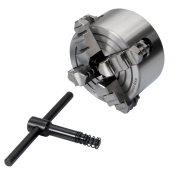 4-Jaw Independent Lathe Chucks
4-Jaw Independent Lathe Chucks
4-Jaw independent lathe chucks have many capabilities, but they take longer to set up. These chucks can center work accurately, they can hold square, rectangular, and odd-shaped workpieces, and they can be set off center.
Each jaw in a 4-Jaw independent lathe chucks can be adjusted independently. They each have their own adjusting screw. Because of this construction, the jaws are reversible, so only one set of jaws is needed.
And, while a lot of folks will tell you that it’s hard to adjust a 4-jaw chuck using trial and error, there is a simple process that makes it a quick operation. Here’s how to center work in a 4-jaw independent lathe chuck.
It’s still not as quick as putting a workpiece in a 3-jaw chuck, so you do not want to leave your 4-jaw chuck on the lathe all the time. Spend the two minutes that it takes to change chucks.
We offer these 4-jaw independent chucks for mini lathes.
| For mini lathes with an 80 mm spindle flange | For mini lathes with a 100 mm spindle flange |
| 3” 4-Jaw Lathe Chuck | |
| 4” 4-Jaw Lathe Chuck with Adapter | 4” 4-Jaw Lathe Chuck |
| 5” 4-Jaw Lathe Chuck with Adapter | 5” 4-Jaw Lathe Chuck and Adapter |
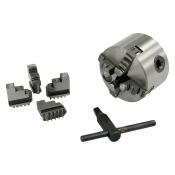 4-Jaw Self Centering Lathe Chucks
4-Jaw Self Centering Lathe Chucks
4-Jaw self-centering lathe chucks are a bit of a strange beast. They are really only good for holding square stock. And they have the centering limitations of all scroll chucks. Don’t get one of these because they are quick to mount a workpiece. They have none of the advantages of a 4-jaw self-centering chuck.
We offer these 4-jaw self-centering chucks for mini lathes.
| For mini lathes with an 80 mm spindle flange | For mini lathes with a 100 mm spindle flange |
| 3” 4-Jaw Self Centering Lathe Chuck | |
| 4” 4-Jaw Self Centering Lathe Chuck and Adapter | 4” 4-Jaw Self Centering Lathe Chuck |
 6-Jaw Self-Centering Lathe Chucks
6-Jaw Self-Centering Lathe Chucks
6-Jaw self-centering lathe chucks are made to hold tubing. The six jaws give more even pressure around the circumference to help prevent distortion. Because of the specialized application there are no outside jaws furnished. The one set of jaws furnished can hold any size of tubing in the rated range.
We offer these 6-jaw self-centering chucks for mini lathes.
| For mini lathes with an 80 mm spindle flange | For mini lathes with a 100 mm spindle flange |
| 4” 6-Jaw Self Centering Lathe Chuck and Adapter | 4” 6-Jaw Self Centering Lathe Chuck |
End Notes
Soft jaws or top replaceable jaws are simply not available on these small chucks. Features like that are available on 6” and larger chucks.

 Chris' Tips
Chris' Tips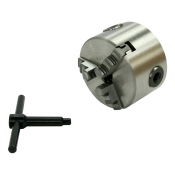 3-Jaw Self Centering Lathe Chucks
3-Jaw Self Centering Lathe Chucks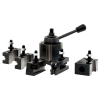 Quick Change Tool Post Set, AXA
Quick Change Tool Post Set, AXA
